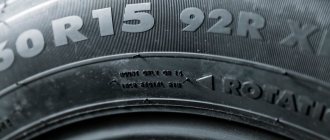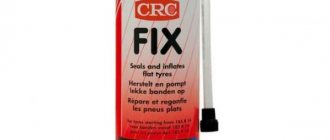About the tread height of new winter tires
Reading time: 4 minutes
The tread depth of new winter tires is very important for the quality performance of any vehicle. With constant driving of any vehicle, wear manifests itself in this way - the tread depth decreases and the driving characteristics decrease. It is important not to allow the minimum depth value, otherwise this will be fraught with unpleasant consequences. Each tire is initially created with a specific size and tread pattern. There are certain indicators of tire wear, which are regulated both by the manufacturers themselves and by third-party independent organizations. You cannot exceed their recommended values.
The meaning of tire tread pattern
The tread pattern performs several very important tasks:
- Helps push water out of the contact space between the wheel and the coating;
- Protects the tire from various mechanical influences, which are caused by the presence of uneven surfaces on the roads, and also prevents puncture of the tire when hitting sharp elements.
Preference for a specific type of pattern is given depending on the conditions in which the car is supposed to be used.
Proper selection of tires will significantly improve the smoothness and controllability of the vehicle, increase efficiency during emergency braking and contribute to a quick response to the steering wheel. Failure to match the selected tread to the operating conditions will significantly reduce the performance characteristics of the vehicle.
Tread height for winter tires
Indicators such as tread height for a new product and depth size can be called basic. It is on them that the tire provides all the qualities and characteristics that are included in it by the manufacturer. The safety of movement fully depends on these indicators.
Different types of winter tires
A normal or acceptable value for this parameter will provide the car owner with the following qualities and properties in full:
- Safety when moving in any conditions.
- Maximum level of handling and grip.
- High dynamic characteristics such as acceleration and braking.
- Smooth ride and soft suspension.
- Permissible level of wear of chassis parts and other important qualities.
Standards, drawing features
Uniform wear on the tire surface
Uneven wear of the tire surface
When using vehicles, the tires wear out, the tread layer decreases - this negatively affects the performance properties of the tread, it ceases to cope with the functions assigned to it.
By studying Table 1, you can familiarize yourself with the minimum remaining tread depth for various vehicles.
Table 1 Remaining tread height for various types of vehicles, provided there is no wear indicator.
A tire is considered unsuitable for use if the depth of the grooves on its surface is less than the minimum permissible height.
The optimal groove height for summer tires is 6-8 millimeters. The permissible wear level is 50%, the minimum tread layer size is indicated in Table 1.
When choosing summer tires, pay attention not only to the tread thickness, but also to the pattern applied to the tire. Products with a symmetrical pattern are considered to be a universal model of summer tires. This type of tire has the following advantages:
- wear resistance;
- low noise level;
- reasonable price.
This is the ideal type of tire for measured driving in urban conditions.
Tires with an asymmetric pattern are suitable for speed lovers. They provide good grip on the road surface when driving at high speeds and cornering. They have the following advantages:
- low noise level;
- good stability;
- improved drainage due to expanded grooves.
The main disadvantage of asymmetric tires is their high cost.
For trips in difficult weather conditions, products with a directional pattern are most suitable. They have a reduced rate of directional stability, which is ensured by a special thickness of the grooves, due to which the rigidity of the outer rim of the tire is reduced. The main disadvantage of these tires is the difficulty of replacing them and the rather high noise level while driving.
Remaining tread height of passenger car tires
The residual or minimum tread depth for tires intended for winter use is regulated by the Road Traffic Regulations. This quality is extremely important for the machine, therefore, in order to avoid accidents and accidents, it is necessary to comply with the permissible depth indicator.
Tires for cars that no longer correspond to the presented parameter must be changed in a timely manner. If a car owner violates this rule, then there is a risk of receiving a fine from a patrol police inspector.
In addition, the uniformity of tire abrasion is of great importance. Manufacturers use a special color layer, by which uniformity can be determined. In this case, the measurement takes place along the entire perimeter of the product. If the car enthusiast has determined uneven wear, it is necessary to check the wheel alignment parameter.
However, constant visual monitoring by the car owner of the condition of the tires is also of great importance. It is necessary to periodically inspect the products for the following damage:
- cracks;
- cuts;
- various surface breaks;
- mechanical damage;
- bumps and all sorts of other damage.
Tire surface wear depends on the following:
- natural wear of tires due to loads and intensive use;
- incorrect alignment of wheels and tires, leading to uneven wear;
- inconsistency with the seasonality of tires;
- high mileage;
- incorrectly selected type of tires;
- driving too fast on ice, potholes and off-road conditions;
- aggressive driving style;
- lack of control of correct tire pressure.
Features of tread residual measurement
In order to determine how badly your tires are worn, it is worth measuring the tread depth. This procedure can be performed in several ways:
- Using a coin placed edgewise into the tread groove;
- Using a special ruler or caliper with a depth gauge;
- Using special professional devices.
The height of the pattern should be the same around the entire perimeter of the product. The need to replace tires can be signaled by a colored layer (indicator). The tire used must be measured across its entire circumference and width to determine uniform wear. If the indicators differ, it is worth checking the adjustment of the alignment angles of each wheel for camber and toe. A visual inspection will also give you an idea of the condition of the tires you are using. Serviceable tires should not have cracks, cuts, cord breaks or mechanical damage that could affect the integrity of the tread and side parts. If you discover defects, it is worth replacing the faulty part to prevent unpleasant situations from occurring. It is important to install new tires on the drive wheels, and so that the handling qualities are not affected when changing products, a pair of tires must be simultaneously secured to the same axle.
What is the minimum tread height for summer and winter tires?
At the moment, it is very important that the “Road Rules” clearly regulate both the amount of tire wear and the permissible tread depth for both summer and winter tires. It is stated that winter tires should not have less than 1.6 millimeters of tread remaining. If this value is exceeded, then there is a risk of paying a fine at best. At worst, this is fraught with unpleasant consequences for the health of the driver and passengers.
It is better not to wait until the 1.6 millimeter mark is reached, but to replace the tires on all wheels in advance. For comparison, you should know that all manufacturers for new winter tires set the initial tread depth in the range from 10 to 15 millimeters.
In addition, there are also certain subtleties for measuring residual depth. It is recommended to measure at as many points or locations as possible to see uniformity.
As for summer tires, the remaining tread depth should also not exceed 1.6 millimeters. However, this only applies to passenger cars. For trucks, this size should not exceed one millimeter, buses - two millimeters, and motorcycles and mopeds are limited to 0.8 millimeters.
Why is it important to control the tread depth on winter tires?
The fact is that the described residual depth parameter plays a vital role for car tires. And they, in turn, are the main component of the car, on which many indicators and characteristics of handling and road grip directly depend.
The use of worn rubber is unacceptable due to the fact that it does not have the proper characteristics and is unsafe.
The use of excessively worn tires is unacceptable according to the regulations of both car manufacturers and the tires themselves. In addition, the traffic rules outline acceptable indicators for various types of transport. Failure to comply with them is punishable by law.
Results
When operating a vehicle, it is necessary to regularly (at least once a season) check the tire depth, especially if you have been using them for a long time. If you don't replace your tires on time, you risk getting into a traffic accident. The service life of all tires is ten years, but experts recommend replacing them after 6 seasons.
Why is it so important to change tires on time? The fact is that when tires wear 50%, road grip deteriorates by 30%. Resistance to hydroplaning is also reduced. The car becomes noisy and difficult to control. But knowing how to measure tread depth and the standard depth for each brand, you can easily determine for yourself whether your “iron horse” needs to change tires or not.
Tread depth of winter and summer tires
The safety of driving a car depends on many factors, but one of the main ones is the condition of the tires, the height or depth of the tread. It is the tires, taking into account the seasonality - summer and winter - that provide excellent grip on the roadway surface.
Tires come in a variety of varieties, depending on the vehicle for which they are selected.
If we talk about passenger cars, the main types are as follows:
- summer;
- winter (studded or Velcro);
- by purpose - off-road (for SUV), sports, regional, highway;
- all-season.
Tread depth of new summer tires: what and permissible
Unlike the summer version, tires for use in winter with more than 50% wear are no longer suitable. Naturally, they still allow you to move on a clean road without snow and ice, but the driver may forget about his safety.
The pattern of each stripe is designed taking into account its place on the tread. Therefore, a tire with an asymmetric tread has an “outside” side and an “inside” side. And since such a “composite” pattern usually has at least one track with a directional pattern, such tires are divided into left and right, and are placed only on one of the two sides of the car.
The largest group of drivers purchases tires directly from a car repair shop or tire service - 36%. However, the study also showed something very alarming - 16% of drivers buy used winter tires. And almost no one buys a set there. If one tire on a car wears out, a replacement is purchased to replace it. This pattern - arrows (or ticks), diverging at the ends from the central axis to the periphery, quickly removes liquid from the area of contact of the tire with the road (forward and to the sides), and “pulls” the car well on a slippery surface, in the snow.
Summer tire tread height
For a regular passenger car, the tread height of new tires is 7.5-8.5 mm . Provided that you purchase tires for driving on public asphalt roads.
If the car owner is the owner of an SUV or crossover and often goes off-road, the tread depth should be around 17 mm, due to the protruding cups and lugs.
Just in case, let us remind you that from January 1, 2020, new clauses were introduced into the rules for admitting vehicles to operation, according to which the residual tread depth cannot be less than 1.6 mm for passenger cars. This applies to both summer and winter tires. Although, it is advisable to install new tires when the tread has worn down to 2 mm. There is a special icon on the court - TWI, which determines the degree of wear.
You need to understand that there are no specific standards for the tread height of new tires. If you stop by a serious store, you should first of all pay attention to the manufacturer: Nokian, Michelin, Goodyear, Bridgestone and many others. These companies are famous for their high quality, so if you buy their products, you will be completely satisfied.
The tread height will be within 8 mm. It is allowed to reduce it in cases where we are talking about tires for high-speed driving in sports mode. The depth then can be approximately 5-6 millimeters.
Car types
There are different types of cars that have different designs, overall dimensions, weight and much more, which is why the tread height of new tires must be different.
If we talk about types of cars, then, for example, the tread height of new tires for sports cars and race cars should be within 5 mm. And already for crossovers and other off-road vehicles within 17 mm.
Winter tire tread height
For winter tires, tread depth is critical. If in the summer you can safely drive on dry asphalt with almost “bald” tires, then in the winter your safety depends on the quality of the tires, especially when driving at high speeds.
Winter “footwear” for passenger cars can be divided into three types:
- studded;
- Scandinavian type;
- frictional
The Scandinavian type and spikes are specially designed for frosty and snowy winters. The tread depth of new winter tires is 9-10 millimeters . The Scandinavian type of tires is characterized by an asymmetrical sparse pattern. Rectangular cups push snow and ice, which are discharged through small slots - lamellas.
Studs, in principle, do the same job - break up snow and ice, providing traction.
Such tires are, of course, suitable for driving on asphalt, but they will make a lot of noise. In addition, you risk losing all the studs when braking sharply on bare asphalt.
The friction type of winter tires is ideal for driving in warm winters with little snow, in slush and mud. The tread depth here is usually about 9-11 mm. Thanks to thin slots and lugs, the grip surface on wet asphalt increases, and all moisture is removed through the sipes. As a rule, friction rubber has a symmetrical tread pattern.
Good winter tires usually last 4 seasons. That is, the tread wears off much more slowly than in summer.
Types of summer tire tread patterns
Summer samples have a texture consisting of wide protrusions and narrow grooves. At the same time, there are almost no lamellas (slots) in such options. This design contributes to low noise levels and high wear resistance.
There is a clear distinction between the types of patterns depending on road conditions - in this case, rubber is divided into three types:
- With a symmetrical pattern - this type has a symmetrical texture on the surface and is a universal option that is used by most car owners;
- With a directional texture - this option is not yet very popular among vehicle owners. It is very effective in suppressing hydroplaning, but is not suitable for high speeds;
- Asymmetrical tread pattern. This option combines the features of good high-speed traction and efficient water drainage. This type is perfect for trails and will also be useful on wet asphalt.
There are also racing variations that have low profile and hard tires. This option is good for sports cars and other cars that can reach speeds of up to 300 km/h.
Tread depth by size
It is also worth noting that the tread height largely depends on the standard size. So, for summer tires the depth will be:
- 165/70 R13 - 7-7.5 mm;
- 175/70 R13 - 7-9 mm.
If we talk about universal or winter tires, the picture is as follows:
- 175/70 R13 - 9-11 mm;
- 187/70 R14 - up to 12 mm;
- 195-205 by 14 - 11-15 mm.
In Russia, in particular, there is a specially approved methodology that provides recommended parameters. Domestic manufacturers adhere to them so that their products comply with GOST.
The Importance of Tread Depth
The permissible tread height of summer tires is an important parameter that determines the possibility of further operation of the tires or the need to replace them.
The depth of the tread pattern affects the quality of the vehicle's grip on the road surface. The level of safety of the driver, passengers, and other road users will depend on how reliable the tires are. The permitted tread depth on summer tires is prescribed in traffic regulations so that motorists do not create an emergency situation. You should not save the rubber until the cord is exposed, as this will be an unjustified risk. Over time, any tires become bald, and on a slippery road the car can skid. Using such worn tires can lead not only to unpredictable consequences on the road, but also to the payment of a fine.
In summer, the ambient temperature can be very high, so summer tires are made of harder rubber. One of the main features of this type of rubber is the protection of the car from aquaplaning, which is achieved due to the presence of longitudinal stripes of the pattern. The finer the tread texture, the more the car's grip on the road decreases.
https://www.youtube.com/watch?v=6lQufRWMN9g
Each manufacturer regulates the permissible tread depth of summer tires for passenger cars. This indicator may differ for different tire models. The optimal size of the tread pattern can be calculated using a special program that calculates the parameters for successfully removing excess fluid from the contact patch. Summer models have a less deep texture when compared to winter tires.
The tire tread height depends on the function that the wheels of a particular car are designed to perform. According to this indicator, all tires are divided into:
- Regional;
- Sports;
- Off-road;
- Road.
Each variant will have a different tread pattern. As for the question of what tread depth should be on summer tires, it is worth taking into account the purpose of the car, the season and the type of transport. For off-road and sports wheels, the tire tread depth will be up to 17 mm, and in road models this value can reach about 5 mm.
It is important to replace tires promptly with the arrival of the new season. If the air temperature exceeds 5 degrees Celsius, winter tires will wear out very quickly. As for summer tires, they begin to crack or wear out when the ambient temperature drops below 7 degrees. Depending on the purpose of the wheels, it is worth regularly checking the tread balance for summer tires according to traffic regulations at a certain interval.
Each manufacturing company controls this value. If the permissible tread remaining on summer tires is exceeded, moisture will not be removed from the wheels as effectively, and the performance capabilities of the product will sharply decrease. Depending on the purpose of the vehicle, it is worth checking the serviceability of tires in a timely manner.
Truck and off-road tires
Truck tires are not divided into summer and winter. They initially come with a powerful deep tread designed for a specific type of coating.
For example, the depth of our popular designs - diamonds, houndstooth - also depends on the standard size:
- 240/260-508 (ZIL, GAZ-3307) - 16.3-18.3 mm;
- 280/300/320-508 (LAZ, MAZ, KamAZ, ZIL) - up to 23 mm.
Well, for special rubber, for example for mining dump trucks, there are special requirements and the depth can significantly exceed the specified values.
For crossovers and SUVs with a standard size of 205-255 and a radius of 15-18 inches, all-terrain, the tread depth ranges from 12 to 17 millimeters. In principle, there is no special need to measure this parameter - height, when purchasing at a dealer store - since the quality and condition are visible to the naked eye.
What if I don't travel much?
Many motorists drive only a few thousand kilometers a year. This does not mean that the tires will last you for several decades. According to Russian requirements (GOST 4754–97), the service life of passenger car tires is 5 years from the date of manufacture. For example, the Continental company indicates in its recommendations that all car tires (including the spare tire) older than 10 years old should be replaced with new ones. Therefore, with low mileage, you can focus on ten years. The date of manufacture of the tire is indicated on the sidewall. Usually it is an oval with four numbers. The first two are the serial number of the week in the year, the last two indicate the year.
How to extend the life of tires?
We can advise you to use your tires carefully and, most importantly, to store them properly in the off-season. First of all, during storage, it is important to prevent the tires from being exposed to direct sunlight, which greatly ages the rubber. Tires without rims should be placed vertically and stacked on rims.
And before you install tires on your car at the beginning of the season, assess their condition. There should be no cracks in the tread or sidewalls. The tire should not be dry, it should remain rubber and not look like caked plastic.
Do winter tires last as long?
The actual service life of winter tires rarely exceeds 30,000 km. “Bald” winter tires without studs can be rolled in the summer, but their grip on the heated road surface will be very poor. This must be taken into account, especially when braking.
So: tires that have not yet had time to wear out on the tread (that is, up to 1.6 mm of tread depth for summer tires, 4 mm for winter tires) are replaced either ten years after the date of manufacture, or when the rubber layer of the tire cracks, or when damaged.
- Find out what tire wear is considered critical here.
What laws govern
Requirements for tread height or depth are contained in Chapter 5 of the Russian Traffic Regulations. And the degree of wear of a part that does not allow the use of the vehicle is reflected in the “List of faults and conditions under which the operation of the vehicle is prohibited.” Both documents indicate what the remaining tread of summer tires should be for different types of cars:
- motorcycles – 0.8 mm;
- passenger cars and trucks weighing up to 3.5 tons, trailers for them - 1.6 mm;
- trucks over 3.5 t – 1 mm:
- buses – 2 mm.
This indicator should normally be higher (accordingly, the degree of wear should be lower). For violation, the driver will be punished under Part 1 of Article 12.5 of the Code of Administrative Offenses:
Driving a vehicle in the presence of malfunctions or conditions under which, in accordance with the Basic Provisions for the admission of vehicles to operation and the duties of officials to ensure road safety, operation of the vehicle is prohibited, with the exception of malfunctions and conditions specified in parts 2 - 7 of this article, entails a warning or the imposition of an administrative fine in the amount of five hundred rubles.
What is the minimum tread height for winter tires?
High-quality tires in winter are the key to your safety. Without this factor, you will not be able to operate the vehicle normally in winter. Since 2020, people in Russia have been actively fined for not having winter tires in the cold season. For now, the fine is 500 rubles, but in the near future it may increase several times. Therefore, it is much more profitable to take care of purchasing a set of tires in a timely manner. If you still have winter tires from last season, you should check how suitable the tires are for use this year. There are legal requirements as well as personal safety considerations. Today in Russia the legislative framework is quite close to the real state of affairs, so you can focus on the features that legislators propose.
Interestingly, many motorists perceive the need to drive in winter on winter tires as quite difficult. In particular, the very fact of duty is confusing. But any driver is well aware that operating vehicles in winter on summer tires is fraught with the most unexpected consequences. To check this fact, you can put on summer tires and drive around a training ground or garage cooperative. And then immediately put on wheels with winter tires and repeat the trip. Even cheap Chinese winter tires may well meet the required performance characteristics of a vehicle in the cold season. And no all-season or summer tire can provide normal safety in winter. Summer tires become “plastic” and very slippery in winter. Let's look at the necessary features of tires in winter.
Minimum tread height as required by law
Until 2010, laws in Russia did not actively regulate the specifics of car operation in the field of tire replacement. You could use any tires you wanted. Then the government thought about a possible reduction in the number of accidents along with improving the technical condition of roads and the insurance business. From that time on, it was possible to drive on tires with a tread height of at least 1.6 millimeters (different types of vehicles had their own requirements. Today, the requirements for tire tread height are as follows:
- summer tires, as well as tires with the M+S designation, can be used up to the wear limit of 1.6 millimeters of tread height;
- winter tires and all other rubber options for the cold season must have a tread of at least 4 millimeters;
- if there are markings on the rubber that indicate the maximum possible wear, after reaching them the rubber remains legal (there is only a requirement of 4 millimeters);
- all factory designations are intended for drivers personally; traffic police officers do not have the right to fine a motorist based on worn-off paint on the service layer;
- The winter tread must have a certain shape with cuts, and there must be symbols on the tire that indicate that the rubber belongs specifically to the family of winter tires.
As you can see, the law sets many requirements for motorists and tires, but not all features are taken into account in modern legislation. In fact, 4 millimeters is too low a wear threshold. Wear parameters should be set not generally, but individually. There are options for high-quality sports winter tires, the tread height of which is about 6 millimeters when new. It turns out that after 2 millimeters of tread wear, you will not be able to operate such tires legally. But the factory determined the wear limit at 1.5 millimeters of tread height.
Personal safety - we think about the correct use of winter tires
In order not to cause unpleasant moments in winter, you should use high-quality tires. If you prefer to buy the cheapest tire options, it is better to give preference to Korean tire options such as Kumho. This is not the most expensive, but also not quite a “Chinese” version of car tires, which behave quite adequately on the road. Almost all Chinese manufacturers offer low-quality tire options. If you want to completely rid yourself of the problems of car operation associated with tires in winter, you should think about the following features:
- each manufacturer determines the permissible tire wear, which depends on many parameters of the tire itself, its model and type of production;
- on most tire models there is a connection between the tread, which is located at a height of 5 mm; after overcoming this barrier, it is better not to use rubber;
- many manufacturers, such as Michelin or Bridgestone, produce inscriptions on the tread that are erased after rolling back a certain resource;
- it is better to replace tires at those moments when the manufacturer recommends this in order to avoid inefficient use of tires;
- You yourself will feel that the rubber has lost its effectiveness and can no longer be used on the car, the behavior of the car will change.
All-season tires - reality or myth?
It is mistakenly believed that today many car tire manufacturers offer so-called all-season tires. Allegedly, such tire options can be used both in winter and summer, without worrying about the quality of operation or fines from traffic police representatives on the road. In fact, this is another myth, inflated by ill-conceived tire advertising in our country. M+S (Mud and Snow) tires, which are considered all-season, have the following disadvantages:
- on a wet surface such tires behave simply disgustingly, the braking distance increases significantly;
- low temperatures cause changes in the chemical characteristics of the tread, increasing the wear of such tires;
- in summer the tires turn out to be too soft, and in winter they become quite hard and uncomfortable for travel;
- on snow, the M+S performs about the same as summer tires, so all-season performance is deceptive;
- at the traffic police post you will still be fined for not having winter tires on the wheels, which are designed specifically for winter;
- fuel consumption will increase significantly both in winter and summer, the tire will cause additional costs.
It should be noted that the term M+S comes from the world of off-road vehicles, where the designation Mud and Snow means the ability to travel on muddy surfaces and in snow. This does not mean that the manufacturer offers an all-season solution for passenger cars. But the glory of M+S's all-season capabilities is firmly ingrained in the thinking of our drivers, who strive to save on vehicle maintenance and operation. Therefore, we do not recommend using any all-season tire options. We invite you to watch a report on the quality of various tread patterns on winter tires:
Let's sum it up
The optimal tires should be selected according to the season. Your car will feel confident only if you have tires that are fully suitable for the operating temperature and the coating under the wheels. Of course, in our country it is not easy to guess the period when it is worth changing tires, but the law has begun to stipulate more stringent calendar limits, so today all drivers must rely on the requirements of official documents. The minimum tread height of winter tires must be 4 millimeters by law, but for safety reasons it is better not to go below 5 millimeters.
Excessive wear on winter tires can lead to an unpleasant situation, since bald winter tires are no better than summer tires. You will get an increased braking distance, unpredictability of the car in difficult conditions, as well as a lot of other troubles. It is better to monitor the quality of the car and change tires long before they finally become poor in use. You should also avoid very cheap and not the highest quality tire options from China and other countries known for the cheapness of their products. How do you use winter tires on your car?











